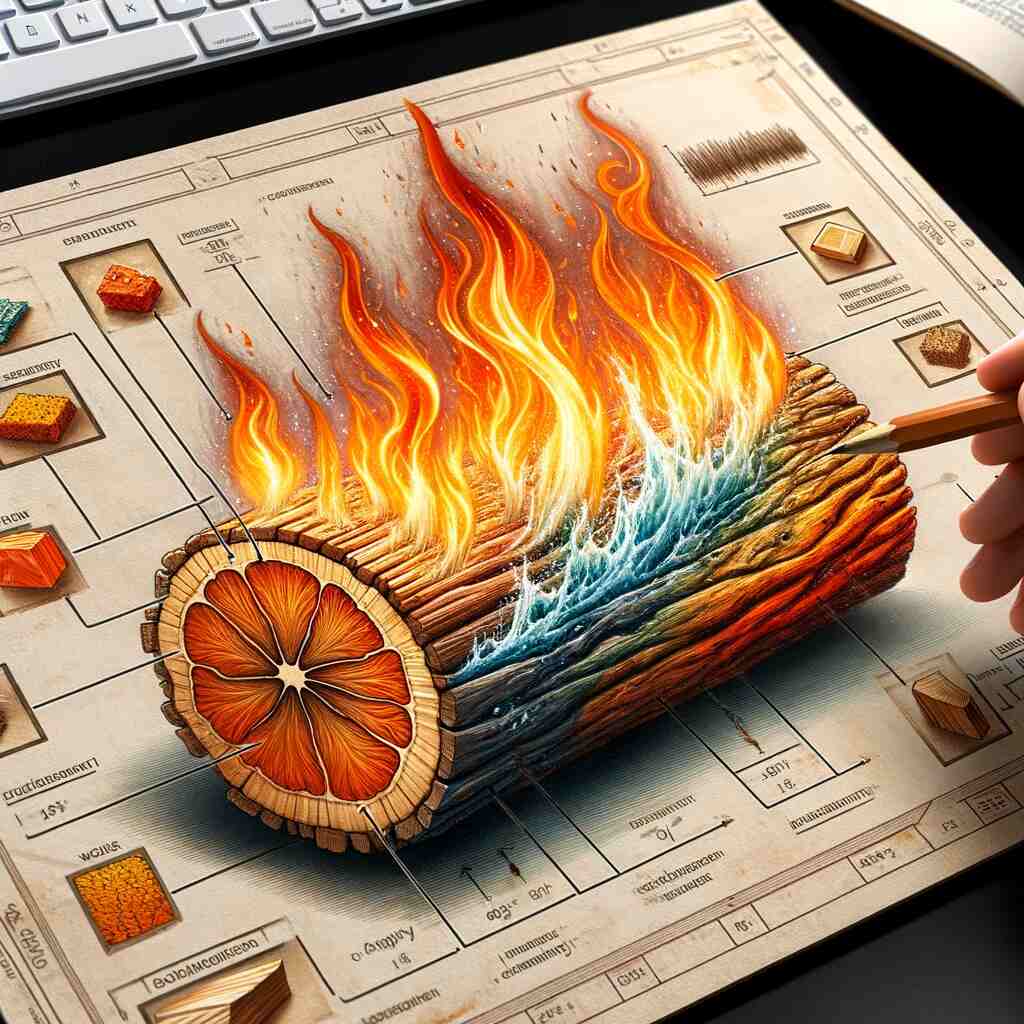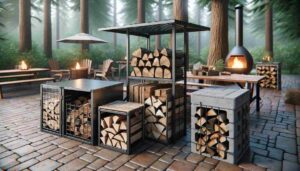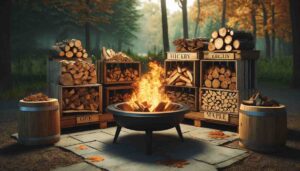Throughout human history, wood has served as a primary source of fuel for heating and cooking. Understanding the burning properties of different wood types is essential for efficient and safe usage. Among the many factors influencing wood’s burning characteristics, questions often arise about whether its color or texture can provide insights.
Yes, the color and texture of wood can provide clues about its burning properties. Darker woods are often denser and can burn longer and hotter, while the texture indicates density and moisture content. Dense, hardwoods with a fine grain, like oak, tend to burn slower and produce more heat than softer, coarser-grained woods like pine.
However, factors like moisture content and wood type also play significant roles, so color and texture are indicators rather than definitive predictors of burning properties.
In this comprehensive article, we will explore the relationship between the color, texture, and burning properties of wood, enabling you to make informed decisions when selecting firewood.
The Science of Combustion
Before delving into the correlation between wood color, texture, and burning properties, it is vital to grasp the science behind wood combustion. When wood undergoes combustion, it engages in a chemical reaction with oxygen, yielding heat, light, and several byproducts, including carbon dioxide, water vapor, and ash.
The primary components of wood that influence combustion include:
Moisture Content: Wood’s moisture content significantly impacts its combustion. Green or wet wood, characterized by high moisture levels, expends a substantial portion of the energy produced during combustion on water evaporation. Conversely, dry wood burns more efficiently and generates more heat.
Density: Wood density closely correlates with its burning properties. Dense wood contains more energy and burns slowly, creating a long-lasting, intense fire. Lighter, less dense wood tends to burn quickly and might not offer a consistent heat output.
Resin and Sap: Certain wood types contain resin or sap, which can influence combustion. Resinous wood may produce more sparks and smoke, while sap can contribute to creosote buildup in chimneys and stoves.
Now, let’s investigate whether wood color and texture can offer clues about its burning properties.
Wood Color and Burning Properties
Wood exhibits a wide range of colors, from pale whites and yellows to dark browns and reds. While wood color can be aesthetically pleasing, it does not directly correspond with its burning properties. Instead, wood color primarily derives from its species and can vary substantially within a single species.
Hardwood vs. Softwood: The most significant distinction concerning burning properties lies between hardwoods and softwoods. Hardwood trees, such as oak, maple, and cherry, generally yield dense, slow-burning wood with high energy content. In contrast, softwood trees like pine, fir, and spruce produce less dense, quicker-burning wood. While hardwoods are often darker in color, this is not a strict rule, and exceptions exist.
Sapwood vs. Heartwood: Within a single tree species, variations in color can occur due to the presence of sapwood and heartwood. Sapwood, found near a tree’s outer rings, is typically lighter in color and burns more quickly. Heartwood, located in the inner rings, is denser and provides a longer, hotter burn. However, color alone is an unreliable indicator of burning properties.
Aging and Weathering: Over time, the color of wood can change due to aging and weathering. Exposure to sunlight, moisture, and air can darken wood, but this does not necessarily affect its burning properties.
In summary, wood color can offer some general insights into a wood’s species and age but is not a dependable indicator of its burning properties. When selecting firewood, it is more important to consider the specific wood species, along with factors like density, moisture content, and resin content.
Wood Texture and Burning Properties
Wood texture refers to the physical characteristics of the wood’s surface, encompassing its grain, smoothness, and hardness. Texture primarily depends on the wood’s species and growth conditions. Although texture can provide some insights into burning properties, it is not the sole determining factor.
Grain Pattern: Wood grain patterns differ among species. Some woods exhibit tight and straight grain patterns, while others feature more open and irregular ones. Woods with tight grain patterns generally burn more slowly, yielding a longer-lasting, hotter fire. Nevertheless, grain patterns alone may not be sufficient for an accurate assessment of burning properties.
Hardness: Wood hardness, often measured using the Janka hardness test, can influence combustion. Hardwoods are generally denser and harder than softwoods, resulting in slower combustion and more sustained heat production. Wood hardness can be a valuable indicator of burning properties but should be considered in conjunction with other factors.
Texture and Surface Features: Certain woods may possess distinctive surface features such as knots, burls, or irregularities. While these features can affect wood splitting and processing, they may not have a significant impact on burning properties once the wood is properly seasoned and prepared for use.
The Importance of Seasoning
One critical factor that transcends wood color and texture is the seasoning or drying process. Freshly cut wood contains a high moisture content, which can hinder combustion efficiency. Properly seasoned wood, however, has undergone drying, reducing its moisture content to a level conducive to efficient burning.
Seasoning wood entails stacking it in a well-ventilated area and allowing it to air dry for an extended period, typically ranging from six months to a year, depending on the wood’s species and size. Well-seasoned wood burns more cleanly and efficiently, producing more heat compared to green or wet wood.
Regardless of wood color or texture, selecting seasoned firewood is paramount for achieving optimal burning properties. Seasoned wood is less likely to generate excessive smoke, cause creosote buildup in chimneys, or produce a feeble flame.
Wood Species and Their Burning Properties
To gain a better understanding of the relationship between wood color, texture, and burning properties, let’s explore specific wood species and how they perform as firewood. Here are some examples:
Oak (Quercus spp.): Oak, a hardwood, is renowned for its exceptional burning properties. It produces a prolonged, high-temperature burn, making it a popular firewood choice. Oak wood can vary in color from light tan to dark brown, and its tight grain pattern contributes to its slow combustion.
Pine (Pinus spp.): Pine, a softwood with a light color and typically straight grain, is easy to ignite but burns relatively quickly. It is suitable for kindling and starting fires but may not be ideal for prolonged heating due to its lower energy content.
Maple (Acer spp.): Maple, another hardwood, burns well, providing a consistent, moderate heat output. It often displays a pale color that may darken with age. Its hardness and density enhance its desirable burning properties.
Cherry (Prunus spp.): Cherry wood, a hardwood with a reddish-brown color, burns well, emitting a pleasant aroma and a moderate heat output. Cherry is often chosen for its aesthetic appeal when used in wood-burning stoves or fireplaces.
Cedar (Cedrus spp.): Cedar, a softwood known for its aromatic qualities, ignites easily and releases a delightful scent. However, it burns relatively quickly and is best combined with hardwoods for an extended, hotter fire.
Hickory (Carya spp.): Hickory, a hardwood with a high energy content, boasts excellent burning properties. Its dense, tight grain pattern produces a hot, long-lasting fire. Hickory wood is frequently used for smoking meats due to its distinctive flavor.
These examples illustrate that wood’s burning properties are primarily determined by its species rather than its color or texture. When selecting firewood, consider the specific wood species and its reputation for burning efficiency.
The Role of Moisture Content
One of the most critical factors affecting wood’s burning properties is its moisture content. Regardless of wood color, texture, or species, moisture content significantly influences combustion efficiency and heat output.
High Moisture Content: Green or freshly cut wood, containing high moisture levels, consumes a significant portion of the energy produced during combustion to evaporate water. Burning such wood is inefficient and may result in excessive smoke. Green wood can be challenging to ignite and might smolder rather than burn cleanly.
Properly Seasoned Wood: Seasoning wood by allowing it to dry over time reduces its moisture content to an optimal range of 15-20%. Well-seasoned wood ignites easily, burns cleanly, and generates a consistent, high heat output. Seasoning also prevents creosote buildup in chimneys, reducing the risk of chimney fires.
The Importance of Moisture Meters: To gauge firewood’s moisture content accurately, consider using a moisture meter designed specifically for wood. This tool offers a quick and reliable means to assess wood’s readiness for efficient burning.
Choosing the Right Wood for Your Needs
When selecting firewood, it is essential to consider your specific requirements and the intended use of the wood. Different wood types excel in various purposes, including heating, cooking, or creating ambiance in a fireplace.
Heating: If your primary use for wood is heating, hardwoods like oak, maple, and hickory are excellent choices. They produce a long-lasting, consistent heat output, making them ideal for warming homes or cabins during cold periods.
Cooking: For cooking and smoking foods, fruitwoods like apple, cherry, and pecan are popular options. They impart a pleasant flavor to food and burn at a moderate temperature.
Ambiance: If your aim is to create a cozy ambiance with a fireplace, you can choose wood for its aesthetic qualities. While hardwoods like oak and cherry are still suitable for this purpose, softer woods like cedar release a pleasant aroma when burned.
Kindling: Softwoods like pine and fir are excellent choices for kindling due to their ease of ignition. They facilitate quick fire starting, even when used in conjunction with hardwoods for sustained heating.
Outdoor Fires: When burning wood in an outdoor fire pit or campfire, you have more flexibility in wood selection. Softwoods can be suitable for rapid, roaring fires, while hardwoods can provide an extended burn for a pleasant outdoor evening.
Storing and Preparing Firewood
Properly storing and preparing firewood is essential to ensure optimal burning properties. Here are some tips:
Seasoning: As previously mentioned, allow freshly cut wood to season for at least six months to a year in a dry, well-ventilated area. Seasoning reduces moisture content, enhancing combustion efficiency.
Splitting: Splitting wood into smaller pieces increases surface area, promoting faster drying. It also makes wood more manageable for stacking and handling.
Stacking: Stack firewood above the ground on a dry surface, such as a pallet or concrete blocks. Utilize a cover or tarp to shield wood from rain and snow while permitting air circulation.
Handling Moisture: Avoid stacking wood directly on the ground, which can draw in moisture. Ensure proper ventilation in your storage area to facilitate drying.
Checking Moisture Content: Employ a moisture meter to periodically assess firewood’s moisture content. Wood with moisture content below 20% is typically considered well-seasoned and ready for efficient burning.
Safety Precautions: When storing firewood, take safety precautions to prevent pests such as termites or rodents from infesting the woodpile.
Conclusion
In summary, while wood color and texture can be visually appealing, they are not reliable indicators of its burning properties. When selecting firewood, focus on factors such as wood species, moisture content, and density, as these are the primary determinants of how well the wood will burn. Proper seasoning and storage play crucial roles in ensuring wood’s readiness for efficient and safe combustion.
By comprehending the science of wood combustion and the characteristics of various wood types, you can make informed choices when selecting firewood for heating, cooking, or recreational purposes. Whether you prefer the slow, consistent burn of hardwoods or the quick ignition of softwoods, selecting well-seasoned wood and adhering to proper burning practices will allow you to enjoy a warm, safe, and efficient fire.









